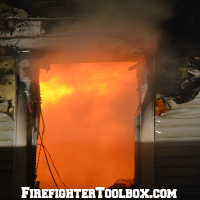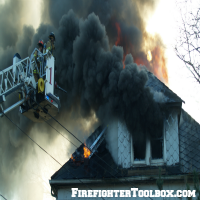The Fire Behavior 360°
The 360° size-up is a must do task at every structure fire. It provides us with vital information to many factors so we as fire officers can formulate our IAP (incident action plan) to best attack and extinguish the fire. This is accomplished by actually walking around the structure and looking for clues and cues. Simply obtaining a three-sided view from our apparatus upon arrival is not effective and we may be missing the bigger picture.
Here is what I feel are two of the most important factors to look for so we can make the best decisions to bring the situation under control as safely and effectively as possible.
 Openings
Openings
The doors and windows provide the most obvious clues as to what is happening inside of the structure.
What to look for:
- Number of openings
- The locations
- Fire conditions
It’s important to know how many and where they are not only for a secondary means of egress but also what fire conditions can we see. It is important to note if these openings are intact or have failed due to rapid fire progression. If the windows have failed, there is little we can do to control the impending flow path without either closing/controlling the doors or creating a new path for the products of combustion to travel to.
 Smoke
Smoke
Due to the newer products that are burning in our homes and business these days, flashover is occurring in as little as 3-5 minutes. With modern building construction taking a turn towards cheaper and more energy efficient practices, rapid fire progression and/or collapses will occur more violently and more frequently.
What to look for:
- Volume
- Turbulence
- Direction
The volume and turbulence of smoke will tell us how much time that we have to extinguish the fire. If the smoke is turbulent and under pressure, this tells us that the heat release rate (HRR) is rapidly increasing and time is critical. Turbulent smoke will look angry and have a boiling effect.
With the newer products that are burning we need to realize that they are made up of frozen class B fuels. Petroleum products will produce black acrid smoke not always associated with high heat.
This leaves the direction or “flow path” of the smoke. Smoke is a product of incomplete combustion that is unburned fuel comprised of particulates of gases and vapors that have yet to meet the right mixture to sustain flaming combustion.
Reading the smoke is like reading an instruction manual. The volume, turbulence, and direction will dictate our future actions.
Better Size-Ups
Here are three ways to become better at size-ups:
- Use the TIC (thermal imaging camera) on the walk around. Look at the heat signatures of the openings. Make a mental note of where the products of combustion are accumulating or traveling.
- If a door is open, close it! This will buy us time to get our attack lines into place without allowing more oxygen into the fire.
- Communicate the information to everyone via radio. Help others to see the bigger picture so we all become safer and more efficient on the fireground.
Using the cover photo, post your size-ups in the comments below. Remember to keep it brief and concise.
Photos courtesy of John Dixon and Brett Dzadik.






Great Article John!
Ethan-
Thank you for taking the time to comment. Glad you find value in the article. Be safe!
Great idea in theory but is the first arriving officer doing this or the first arriving chief? If it’s the first officer and it’s a company officer I think the time would be better spent stretching a line and starting the attack especially if it’s an undermanned company. If the company officer has done his job he shouldn’t need a 360.to find the openings this could be done during his pre-planning inspection thus providing him with a start for his IAP. This will also provide information as to where the flow paths are(I still call it ventilation got to love these new terms for things we’ve doing for years) a quick attack may just keep us from burning this place to the ground and killing its occupants while we conduct the 360!!!
Additionally a 360 might be very difficult in an urban setting when attached buildings can stretch a city block or be surrounded by fences and other obstacles making a 360 a very time consuming or impossible task remember the 3-5 minute flashover time frame? How long do you think it would take to do a 360 in the building pictured in this article? If your department is truly progressive this 360 could be done by a chief’ s aide thus leaving the chief free to conduct operations. The aide could radio his findings in real time to the chief. (Best case scenario) the fire service needs to stop mailing excuses to keep us from entering burning buildings. A well co- ordinated interior attack in my opinion still the best way to save LIVES and property REMEMBER what we are sworn to protect,,,,
Brother John,
Great article on the one of the most undervalued and underused tactics in our toolbox: The 360. Many firefighters and occupants have been lost due to a lack of solid first hand fire ground information that is only gathered by a 360. Pre-plans as stated are a great resource but they will not give you the accurate “what’s happening right now” picture of the fire ground. An officer who performs this tactic is doing so while his/her crew is amking the stretch and preparing to make entry. My crew forces the door, checks behind the door, and closes the door until I complete my 360 thereby making the best use of our time. Basements, victim locations, structural hazards, the location of the fire, and identifying the flow path are some important examples of critical fire ground factors that are gathered through a 360. There are numerous NIOSH reports that warn us of the hazards of not “taking the time” to perform this tactic. We are here to serve and protect as previously stated but firefighters should make the best decision not merely the quickest decision. Great article and keep up the great work.
Thanks for educative article Mr Dixon